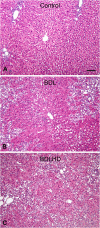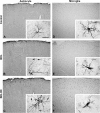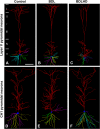Morphological changes of cortical pyramidal neurons in hepatic encephalopathy
- PMID: 24433342
- PMCID: PMC3898242
- DOI: 10.1186/1471-2202-15-15
Morphological changes of cortical pyramidal neurons in hepatic encephalopathy
Abstract
Background: Hepatic encephalopathy (HE) is a reversible neuropsychiatric syndrome associated with acute and chronic liver diseases. It includes a number of neuropsychiatric disturbances including impaired motor activity and coordination, intellectual and cognitive function.
Results: In the present study, we used a chronic rat HE model by ligation of the bile duct (BDL) for 4 weeks. These rats showed increased plasma ammonia level, bile duct hyperplasia and impaired spatial learning memory and motor coordination when tested with Rota-rod and Morris water maze tests, respectively. By immunohistochemistry, the cerebral cortex showed swelling of astrocytes and microglia activation. To gain a better understanding of the effect of HE on the brain, the dendritic arbors of layer V cortical pyramidal neurons and hippocampal CA1 pyramidal neurons were revealed by an intracellular dye injection combined with a 3-dimensional reconstruction. Although the dendritic arbors remained unaltered, the dendritic spine density on these neurons was significantly reduced. It was suggested that the reduction of dendritic spines may be the underlying cause for increased motor evoked potential threshold and prolonged central motor conduction time in clinical finding in cirrhosis.
Conclusions: We found that HE perturbs CNS functions by altering the dendritic morphology of cortical and hippocampal pyramidal neurons, which may be the underlying cause for the motor and intellectual impairments associated with HE patients.
Figures








Similar articles
-
Hypobaric hypoxia induces dendritic plasticity in cortical and hippocampal pyramidal neurons in rat brain.Behav Brain Res. 2008 Jun 3;189(2):233-43. doi: 10.1016/j.bbr.2008.01.007. Epub 2008 Feb 2. Behav Brain Res. 2008. Retraction in: Behav Brain Res. 2024 Jun 25;468:115016. doi: 10.1016/j.bbr.2024.115016. PMID: 18321600 Retracted.
-
Hydrocephalus compacted cortex and hippocampus and altered their output neurons in association with spatial learning and memory deficits in rats.Brain Pathol. 2017 Jul;27(4):419-436. doi: 10.1111/bpa.12414. Epub 2016 Aug 15. Brain Pathol. 2017. PMID: 27411167 Free PMC article.
-
Reproductive experience modified dendritic spines on cortical pyramidal neurons to enhance sensory perception and spatial learning in rats.Exp Anim. 2017 Jan 27;66(1):61-74. doi: 10.1538/expanim.16-0061. Epub 2016 Oct 25. Exp Anim. 2017. PMID: 27784858 Free PMC article.
-
SIRT1 activation by resveratrol reverses atrophy of apical dendrites of hippocampal CA1 pyramidal neurons and neurobehavioral impairments in moderate grade hepatic encephalopathy rats.J Chem Neuroanat. 2020 Jul;106:101797. doi: 10.1016/j.jchemneu.2020.101797. Epub 2020 Apr 22. J Chem Neuroanat. 2020. PMID: 32334029
-
Effects of cholestasis and hyperammonemia on dendritic spine density and turnover in rat hippocampal neurons.Sci Rep. 2024 Dec 1;14(1):29841. doi: 10.1038/s41598-024-80871-8. Sci Rep. 2024. PMID: 39617839 Free PMC article.
Cited by
-
Neuroinflammation increases GABAergic tone and impairs cognitive and motor function in hyperammonemia by increasing GAT-3 membrane expression. Reversal by sulforaphane by promoting M2 polarization of microglia.J Neuroinflammation. 2016 Apr 18;13(1):83. doi: 10.1186/s12974-016-0549-z. J Neuroinflammation. 2016. PMID: 27090509 Free PMC article.
-
Role of astrocytes and microglia in hepatic encephalopathy associated with advanced chronic liver disease: lessons from animal studies.Neural Regen Res. 2025 Dec 1;20(12):3461-3475. doi: 10.4103/NRR.NRR-D-24-00600. Epub 2024 Dec 16. Neural Regen Res. 2025. PMID: 39688562 Free PMC article.
-
h-Type Membrane Current Shapes the Local Field Potential from Populations of Pyramidal Neurons.J Neurosci. 2018 Jun 27;38(26):6011-6024. doi: 10.1523/JNEUROSCI.3278-17.2018. Epub 2018 Jun 6. J Neurosci. 2018. PMID: 29875266 Free PMC article.
-
Reduced cortical thickness in patients with acute-on-chronic liver failure due to non-alcoholic etiology.J Transl Med. 2015 Oct 6;13:322. doi: 10.1186/s12967-015-0679-6. J Transl Med. 2015. PMID: 26444271 Free PMC article.
-
Hyperexcitability of the network contributes to synchronization processes in the human epileptic neocortex.J Physiol. 2018 Jan 15;596(2):317-342. doi: 10.1113/JP275413. Epub 2017 Dec 28. J Physiol. 2018. PMID: 29178354 Free PMC article.
References
Publication types
MeSH terms
LinkOut - more resources
Full Text Sources
Other Literature Sources
Miscellaneous

